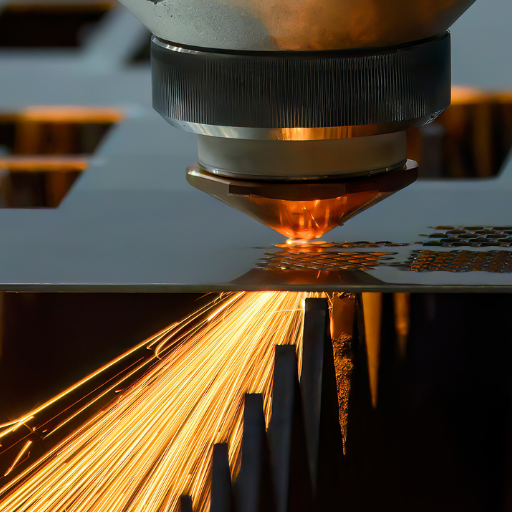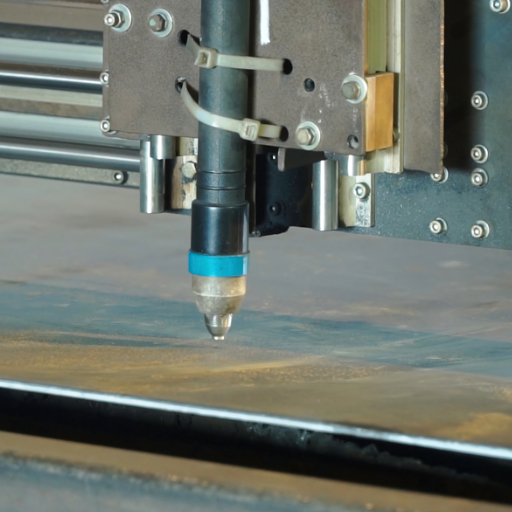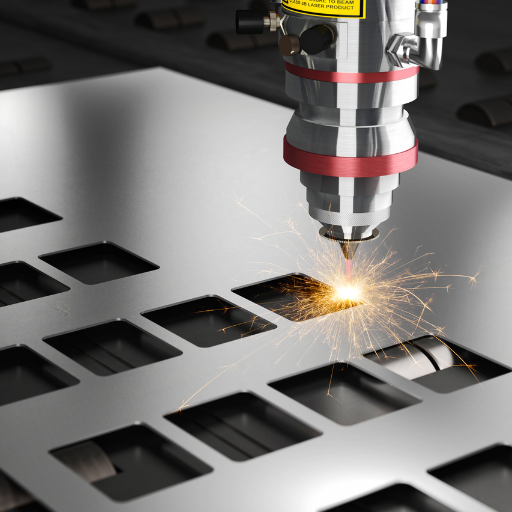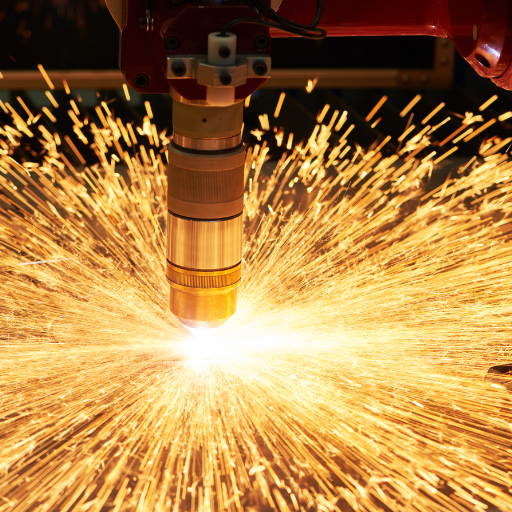Manufacturing and fabrication industries continually develop, embracing advanced technologies that will make their work more precise, efficient and productive. Laser cutting and plasma cutting are among the most notable techniques used in shaping and manipulating materials. Each approach has its unique strengths and thus is appropriate for certain applications. In this blog article, I will review what future of fabrication holds by comparing laser cutting with plasma cutting giving their abilities, benefits as well as possible disadvantages. Consequently, potential users can get insights on whether to choose from these two methods depending on the nature of operations they have in mind during various fabrication processes. Whether you are a veteran professional or new to the world of fabrication, this exploration would give one a perspective on how far the industry is moving concerning technology improvements.
Overview of Laser Cutting
Laser cutting is an extremely precise and flexible fabrication technique which uses a laser beam of high power to cut, melt, or vaporize materials to produce clean and accurate cuts. The process finds extensive application in fields such as automotive, aerospace, electronics etc., as it can be used on various materials like metals, plastics, woods and ceramics with extreme precision. In this method, the laser is focused onto the material’s surface through a computer numerical control (CNC) system to form very intricate shapes. Advantages of laser cutting are that it is fast in cutting speed, produces minimal waste material in cutting complex geometries and leaves superior edges quality. It can however prove costly during initial setup and may struggle with thicknesses greater than a few centimeters leading to its suitability for applications that require great precision but moderate material thicknesses.
How Laser Cutting Works
Laser cutting operates by having a high-powered laser directed at the surface of the material usually generated using CO2 , fiber or Nd:YAG sources. Lens or specific optics focus the beam onto a small area on the material which when it interacts with highly concentrated light melts burns or vaporizes in order to make neat cuts.
Key stages of the laser cutting process include:
- Beam Generation: A source of lasers generates a coherent light beam.
- Beam Focusing: Focus optics direct and concentrate beams into tiny spots on materials.
- Cutting Process: Material melts/burns/vaporizes at focal point while assist gas (air/oxygen/nitrogen) blows away molten substance resulting in clean cut marks.
- CNC Control: By means of pre-designed paths defined by computer numerical control (CNC), the movement of lasers is controlled enabling sophisticated patterns as well as accurate outcomes when cuts are made.
Technical Parameters:
- Laser Power: Ranges from 1 kW up to 10 kW typically affecting both material thickness and cut speed.
- Wavelength: CO2 lasers operate around 10.6 micrometers, fiber lasers at 1.06 micrometers, and Nd:YAG lasers at 1.064 micrometers, with fiber and Nd:YAG laser being more suitable for metals.
- Cutting Speed: Varies between several meters per minute to a few millimeters per second depending on material and thickness as well.
- Kerf Width: Material-dependent mostly lies in the range of 0.1 – 0.5 mm with laser focusing taken into account.
- Material Thickness: Greatest effectiveness is for materials up to about 20 mm thick with different laser types as well as power levels being able to machine various thicknesses.
- Accuracy: With tolerances that may reach ±0.1mm, it can be used where precision is paramount
To determine whether or not laser cutting is viable for given set of conditions relevant user needs to be aware of these things during different fabrication processes.
Materials Suitable for Laser Cutting
- Metals:
- Steel: The high accuracy requirement of this metal allows mild steel stainless steel and carbon steel to be cut perfectly using a laser cutter which can cut through any thickness from as little as half millimeter up-to twenty millimeters.
- Aluminum: Aluminium has to be cut using higher powered lasers due to its reflective nature but it can go up-to fifteen millimeters thick when being laser cut.
- Copper and Brass : These are highly reflective materials that challenging to work with although they could be handled by fiber lasers only which often have capabilities up to about ten millimeters respectively.
- Non-Metals:
- Wood Commonly found woods are plywood MDF and solid wood ranging in thicknesses of up-to twenty millimeters.Laser cutting leaves the most refined edges possible without compromising other intricate designs.
- Acrylic: It can be easily cut with a smooth finish, making it perfect for signages and display pieces; thicknesses are usually up to 25mm.
- Plastics: Materials such as polycarbonate, polypropylene and ABS provide a precise laser cut capability however, the thickness varies depending on type of the materials generally up to 10mm.
- Textiles: Cotton, polyester or felt fabrics will get a clean cut without fraying edges hence suitable for fashion and upholstery industries.
- Composites:
- Carbon Fiber Reinforced Polymers (CFRP): These are used in high-performance applications such as aerospace and automotive, with typical cutting thicknesses up to 10 mm.
- Glass-Reinforced Plastics (GRP): Suitable for applications necessitating durability and strength, generally cut up to 8 mm thick.
- Others:
- Ceramics: Some of these ceramics and tiles can be engraved or precisely cut but need CO2 or fiber lasers specific to them which do not go over 5 mm thick normally.
- Rubber: Gaskets can be made out of rubber through laser cutting having no deformation on the edges ideal for thicknesses up to 6mm.
- Paper and Cardboard: The materials used in packaging and designs that can be delicately cut or engraved without burning have gone thick enough- maximum 3 mm.
Optimizing fabrication processes by understanding individual properties as well as abilities of these various materials when using laser cutting becomes possible. Using a Laser Cutting Machine-The Pros
Advantages of a Laser Cutting Machine
Laser cutting machines have many significant advantages based on my own experience and research. Firstly, they offer accuracy that is unrivalled in any other method which is crucial for complex design works with intricate pattern. Thus precision helps reducing wastage while optimizing material usage leading to highly efficient process. Secondly, I choose laser cutting machines because they are versatile thus one machine takes acrylics, plastics textiles – Etc; therefore I do not need many special tools for diverse projects. Thirdly, the speed at which laser cutting works is important because it saves time compared to using traditional techniques. The clean edges left by laser cutting often eliminate the need for further finishing processes hence saves both time and cost. In conclusion, these advantages make my fabrication process more streamlined and cost effective.
Overview of Plasma Cutting
Plasma cutting is a thermal cutting process where an electrical arc is established between the workpiece and the electrode. This electric arc ionizes gas to produce a plasma jet with very high temperature that melts materials, causing them to be blown away, resulting in clean and precise cuts. In manufacturing and construction industries, plasma cutting finds wide applications especially for conductive metals which include steel, stainless steel, aluminum , brass and copper. These include: it can cut metal plates at high speeds; it has the ability to cut through thick metal plates; it is cost effective for medium to large scale projects. It also allows one to have high productivity rates by catering for different thicknesses of material.
However, plasma cutting cannot achieve similar precision levels as laser cutting does and may leave rougher edges especially on thin materials.
Plasma Cutting Process
The process of plasma cutting begins when an electrical arc is created between an electrode and a conductive material that should be cut. An example of such gas is nitrogen or oxygen or compressed air is forced through a nozzle emitting out as a high temperature plasma jet because of this ionized arc. The drawn-out heat that comes from the plasma stream meltsthe material while the fast-moving gas gets rid of the molten metal leaving behind neat cuts. This method works well with both thin layers as well as thick ones since there are numerous thickness options available due to its flexibility. Moreover, many modern day plasma cutters come fitted with CNC systems allowing for automated highly accurate cuts on intricate shapes or designs. Generally speaking, particularly when it concerns small- to medium-scale industrial applications, this technology has been valued due its quickness in carrying out action plans alongside keeping down costs.
Benefits of Plasma Cutting Metal Fabrication
Again when discussing benefits of Plasma Cutting Metal Fabrication several key advantages emerge which consistently appear across top websites.
Secondly, efficiency and speed are some of the features provided by this method which are paramount in industrial applications. The speed of the plasma jet enables very fast cutting speeds particularly on thicker materials.
On another note, it should be noted that Plasma Cutting is versatile, and can be used on various conductive metals such as steel, stainless steel, aluminum , brass and copper. This means that this technology is invaluable in different areas where metalworking is done. In addition to being extremely flexible when it comes to design implementation, it also has a number of other benefits for medium-to-large-size jobs with fast execution times.
On the technical side, plasma cutting systems are often praised for their CNC capabilities (Computer Numerical Control), which facilitate automated, precise and repeatable cuts for complex shapes or intricate designs. Concurrently with laser cuttings itself in certain instances, this level of precision can be matched though not always surpassed by other approaches like plasma cutting. Besides these facts the capabilities of plasma cutting include: working with thicknesses from 0.5mm all the way up to 150mm plus depending upon equipment being used.
Another benefit accrues from reduced heat-affected zone (HAZ) relative to other thermal cutting techniques. As a result metal close to the cut area does not get distorted due to HAZ reduction during plasma cutting process.As well as starting up more swiftly since less preheating time is needed which leads to improved workflow efficiency overall involving lower lead-times too.
In summary, the speed of plasma cutting, its versatility, cost-effectiveness, CNC accuracy and adaptability to various thicknesses of material make it the preferred method in metal fabrication particularly in high production environments. It may not always be known for its fine edge finish as compared to laser cutting but it is considered as having some benefits regarding productivity and flexibility.
Differences between Plasma Cutters and Laser Cutters
- Cutting Technology
- Plasma Cutters: Use a highly fast flowing stream of ionized gas (plasma) that carries electric charge from the torch of the plasma cutter to the workpiece which melts off the metal and eliminates molten material to form a cut.
- Laser Cutters: They focus a highly concentrated beam of light through optics to perform cuts or engraving on materials. A precise cut is achieved when the laser beam heats up and vaporizes material along the cutting path.
- Material Capability
- Plasma Cutters: Mainly designed for cutting conductive metals like steel, stainless steel, aluminium, brass and copper. They are suitable for different thicknesses starting from 0.5mm up to over 150mm in most cases.
- Laser Cutters: Cuts can involve many other types of materials that include metals, plastics, wood, glass and fabrics. Metal cutting extends from thin sheets up until about 25mm depending on laser power and type.
- Precision and Edge Quality
- Plasma Cutters: For most applications they provide good precision and quality but edge finishes might be rougher than what one might get with laser cutting; tolerance levels are generally around ±0.5mm.
- Laser Cutters: Where tolerances often fall within ±0.1 mm showing outstanding precision as well as edge quality; this is due to their ability achieve sharp edges or corners plus intricate designs by using tightly focused beams of light energy known as lasers.
- Speed of Operation
- Plasma Cutters: Faster especially in cutting thicker materials. In significant industrial applications where speed of cutting is important.
- Laser Cutters: Generally slower with thicker metals than plasma cutters’ counterparts although they are widely used when thin materials and intricate designs are required.
- Cost
- Plasma Cutters: Lower starting costs and running charges. Consumables like electrodes and nozzles are quite cheap.
- Laser Cutters: The initial cost of a laser system is high because it is more complex than other systems of this type. This also includes maintenance, energy consumed and others which may make operating costs to be higher.
- Heat-Affected Zone (HAZ)
- Plasma Cutters: A medium HAZ that can affect the material properties around the cut area therefore necessitating subsequent processing stages.
- Laser Cutters: HAZ with minimum effects on material integrity; typically no additional finishing will be necessary afterwards as well.
- Setup and Maintenance
- Plasma Cutters: They require less time for setting up and simpler maintenance due to their less complicated technology.
- Laser Cutters: Setup procedures are more complicated with greater maintenance demands although some automated systems might reduce these challenges.
Each method has its own advantages over the other depending on the nature of job being done or the kind of material being worked on. The decision as to whether plasma or laser cutting should be employed in a particular project largely depends on factors such as type of material, thickness, precision needed, budget considerations among others.
Comparing Operating Costs: Laser vs Plasma Cutting
When comparing operating costs between laser and plasma cutting, several factors come into play. Plasma cutters typically have a lower initial investment and lower operational costs. Consumables for plasma cutters, such as electrodes and nozzles, are relatively inexpensive and widely available. In contrast, laser cutters have a higher initial purchase price and can incur greater costs in terms of maintenance and energy consumption. The complexity of laser systems often requires more frequent and specialized maintenance, driving up costs. However, laser cutters can increase efficiency for intricate designs and thin materials, potentially reducing overall project time and labor costs. In summary, while plasma cutting is more cost-effective for initial and operational expenses, laser cutting can provide cost savings in specific scenarios requiring high precision and minimal secondary processing.
Initial Investment and Maintenance Costs
Plasma Cutting
- Initial Investment: Plasma cutters generally have a lower initial cost compared to laser cutters. Entry-level plasma cutting systems can range from $1,500 to $20,000, depending on the power and size of the machine.
- Maintenance Costs: Maintenance expenses are relatively low. Key components include consumables like electrodes and nozzles, which need regular replacement but are inexpensive. Annual maintenance costs can range from $500 to $3,000, mainly encompassing consumables and occasional system check-ups.
Laser Cutting
- Initial Investment: Laser cutters have a higher upfront cost, reflecting their advanced technology. Prices for commercial laser cutting machines can range from $10,000 to over $500,000, depending on factors such as laser power (measured in watts), type (CO2, fiber, or YAG), and cutting bed size.
- Maintenance Costs: Laser systems require more frequent and specialized maintenance, which can be expensive. Components like the laser generator, optics, and cooling system are critical and need regular checks. Annual maintenance costs can vary greatly but typically fall between $4,000 and $12,000, including consumables and specialized technician services.
Technical Parameters for Consideration
- Power: Plasma cutters typically range from 30 to 400 amps, suitable for various thicknesses of conductive metals.
- Cutting Speed: Plasma cutters tend to be faster when cutting thicker materials, with speeds up to 200 inches per minute (IPM) for metals around 1-inch thick.
- Laser Power: Commercial laser cutters usually range from 20 to 10,000 watts. Higher wattage allows for cutting thicker materials and faster processing times.
- Precision: Laser cutters offer higher precision, with tolerances as tight as ±0.001 inches, beneficial for intricate designs and fine details.
When considering initial investment and maintenance costs, one should weigh the overall requirements of the projects at hand. Plasma cutting is generally more cost-effective for most applications, while laser cutting shines in scenarios demanding high precision and fine detailing. The choice largely depends on specific needs, including project complexity, material properties, and long-term cost considerations.
Running Costs: Gas, Electricity, and Consumables
Gas Usage
- Plasma Cutting: Cutting gases employed in plasma cutters include compressed air, nitrogen, oxygen or mixtures of argon and hydrogen. The quality of the cut as well as operational costs are influenced by the gas chosen. On average, it cost about $20-$40 for plasma cutting gas to run its operations for every hour. The prices may also differ due to different kinds of gases used and how quickly they can pierce.
- Laser Cutting: In some cases, laser cutting machines use additional gases such as Nitrogen, Oxygen or Carbon dioxide. This gas affects finishing and speed of the cut. The running cost in terms of gases used in laser cutting ranges from $5 and $15 per hour therefore it is more cost effective than plasma cutting in terms of gas utilization.
Power Consumption
- Plasma Cutting: On average a plasma cutter consumes electricity between 3-12 kW each hour during operation. Amount of energy consumed relies on power rating of a machine and thickness of material that is being cut. Energy costs for industries range about from $10-30 per hour.
- Laser Cutting: Laser cutting too consume huge amounts of electricity i.e., 6-20 KW/hr for high-power commercial systems. This means that electricity charges for a laser cutter are generally higher averaging around $15-$45/hourly depending on wattage rates and operational efficiency.
Consumables
- Plasma Cutting: Plasma consumables like nozzles, electrodes as well swirl rings wear out over time hence require regular replacement so as to preserve a good quality cut. Depending on the materials being worked with and amount of cutting done this could range anywhere between $2 to $6per hr.
- Laser Cutting: These types consumables required include protective windows, mirrors among others lenses; these components will last longer compared to those found in plasma but they are costly too .Costs incurred through buying gas for laser cutter are relatively lower ranging from $1 to $4 per hour due to less frequent replacements.
By knowing and considering these running costs, capital expenditure and maintenance expenses, firms can decide the best way to optimize their cutting operations and manage budgets effectively.
Cost Efficiency for Different Materials and Thickness
The cost efficiency of plasma and laser cutting significantly depends on the type of material as well as its thickness. Laser cutting is much more economical when it comes to thin materials (up to 6mm) because it is precise with minimal wastage. The need for additional finishing processes further gets reduced by cleaner edges and finer details provided by laser cutters. However, in thicker section usually greater than 25mm, plasma cutting would be cheaper. Heavy metals are cut better by plasma cutters at a faster rate leading lower overall costs for heavy duty applications.
- Thin Materials (up to 6 mm):
- Laser Cutting: Best for stainless steel or aluminum types of metals due to high precision cutting with little wastage.
- Plasma Cutting: Inefficient with thin materials because they have rough edges which results in higher material waste.
- Medium Thickness (6 mm – 25 mm):
- Laser Cutting: Can maintain precision but may get slower as well as expensive with increasing thicknesses
- Plasma Cutting: Here plasma becomes more viable thus balancing speed with cost especially if not intricate designs are involved.
- Thick Materials (above 25 mm):
- Laser Cutting: Can be used for heavy materials but this would require more power making cuts more costly plus reducing speed.
- Plasma Cutting: Preferred choice for thick materials like carbon steel, providing quicker cuts and lower operational costs.
Businesses can maximize on cost-efficiency without compromising on the optimal performance and quality by choosing cutting technology that suits material type and thickness.
The Influence of Cutting Speed on Project Efficiency
Cutting speed is vital in a project because it will determine how fast and effective it will be. High cutting speeds can help reduce machining time significantly, thus completing projects quicker and increasing its throughput as well. On the other hand, higher rates may lead to increased tool wear necessitating more frequent replacement of cutters and machine parts which eventually increases the cost. It is necessary to optimize both efficiency and quality by maintaining speed alongside factors such as material properties, tool life and precision required for cutting.
Laser Cutting Speed vs Plasma Cutting Speed
When comparing plasma cutting speed with laser cutting speed, we should consider specific materials characteristics and project needs. In most cases involving thinner materials, I found that laser cuts are generally cleaner and more accurate than plasma cuts through various sources on my research. Plasma cutting processes are typically designed for thicker materials like carbon steel where high-speed operations are ideal even when dealing with very tough metals as above said. However, compared to laser cutting, plasma may have some loss in precision terms. Because of that, it depends on the material thickness as well as type, precise achievable dimensions but also operational costs associated with each method of cut.
How Speed Affects Overall Production Time
I found out that the rate at which you cut has a lot of bearing on overall production time in either plasma or laser based systems. This allows one to reduce production time by increasing more parts within a specific duration for example in case of laser cutting when the velocity varies between 20–70 inches per minute (IPM) thin sheets are achieved with little post processing hence high accuracy levels. Materials which enable faster plasma rates include those found in thicker gauges ranging between 20–200 IPM depending on their thicknesses or types.
However, this isn’t always true; sometimes increasing your pace won’t help at all unless there are clear conditions under which it should work. Increased speeds might affect the quality of cuts, especially in the context of plasma cutting where multiple reworking is involved. Other factors that will determine the speed needed include: how powerful the machine is, what material and its thickness you are using, and also how complicated your cut may be.
To justify these findings, consider the following technical parameters:
- Laser Cutting Speed: 20-70 IPM for thin materials (e.g., 1/8 inch carbon steel)
- Plasma Cutting Speed: 20-200 IPM for thicker materials (e.g., 1/2 inch carbon steel)
- Material Thickness and Type: Affects both speed and quality of the cut
- Power of Equipment: Higher wattage lasers can cut faster
- Cut Complexity: Intricate designs require slower speeds for precision
In conclusion, balancing quality and characteristics of material with velocity in a process helps to optimize overall production time while maintaining desired accuracy levels in terms of cuts as well as efficiency.
Choosing the Right Cutting Method Based on Project Needs
Choosing the right cutting method for a project involves evaluating several key factors to ensure optimal performance and efficiency. I can summarize the considerations as follows:
Key Factors for Choosing the Right Cutting Method:
- Material Type and Thickness:
- Laser Cutting: Ideal for thin materials such as 1/8 inch carbon steel, offering high precision (Speed: 20-70 IPM).
- Plasma Cutting: Better suited for thicker materials like 1/2 inch carbon steel, providing faster cutting speeds (Speed: 20-200 IPM).
- Cutting Speed and Quality:
- Laser Cutting: Slower speeds for intricate designs, ensuring fine edges and minimal post-processing.
- Plasma Cutting: Faster for straight cuts in thicker materials but may compromise edge quality.
- Power of Equipment:
- Higher wattage lasers can cut faster while maintaining precision.
- Cut Complexity:
- Laser Cutting: More effective for detailed and complex patterns due to its precision.
- Plasma Cutting: Efficient for simpler and thicker material cuts, albeit with potential for rougher edges.
- Production Needs:
- Balancing speed with desired cut quality and material specifications is crucial for any project.
Technical Parameters Justification:
- Laser Cutting Speed: 20-70 IPM for thin materials
- Plasma Cutting Speed: 20-200 IPM for thicker materials
- Material Thickness and Type: Thin (1/8 inch carbon steel) and thick (1/2 inch carbon steel) materials
- Power of Equipment: Higher wattage for faster laser cuts
- Cut Complexity: Detailed designs require slower, precise cuts
By considering these factors, I can select the most suitable cutting method that aligns with my project requirements, ensuring efficiency and precision.
Determining Which Cutting Machine is Right for Your Needs
Once identifying the appropriate cutting machine to use, there are few critical factors that should be considered. First among these is the need to know the type of materials one works with most often and their thickness. You see, in case of thin materials such as 1/8 inch carbon steel, laser cutting machines come with high precision and fine edges; hence they are very good with intricate designs. However, if you have thicker things like 1/2 inch carbon steel then go for plasma cutting machines since they have faster cutting speeds and more efficiency although much rougher edges could result.
In addition, how complex are these cuts? This is because laser cutting is unrivaled in its ability to cut out detailed and complicated patterns compared to plasma cutting which performs best in simpler, less elaborate safe cuts through thicker material. This means that I also need to think about how much I want to produce each time and at what speed. Higher wattage lasers allow for increased speeds without compromising accuracy, which benefits those shops needing rapid turnaround times on large orders.
Lastly your finances and operational costs should be put into consideration. Laser cutters require a lot of upfront payment but they have low maintenance and operating expenses as well. On the other hand because of their consumables or your continuous need for consumables as well as their frequent breakdowns may make plasma cutters appear cheaper at first but expensive later.
By connecting these considerations with specific project needs one can choose the most optimal machine for his/her job based on speed, accuracy as well as economical factor hence ensuring better outcomes.
Assessing Material Type and Thickness
For me who would want to settle on an ideal cutter after weighing options concerning material type and thickness has certain things that I must take into account when evaluating my position. Such things are a preference for using laser-cutting machines when it comes down to thin materials like 1/8 inch carbon steel due to their unusual high level of precision as well as fine margins and edges that suit intricate designs. However, in manufacturing industries where thick materials such as 1/2 inch carbon steel are used, we prefer plasma cutting machines since they are faster in cutting and more efficient even if the edges may be rougher. To obtain a balance between these aspects, I must keep sight of these nuances and tailor them to my project.
Determining Production Volume And Precision Requirements
Production volume is one factor while precision is another that has to be considered when determining which devices will eventually fit into my projects. The case here is that high output levels require machines operating at relatively higher speeds which makes me go for laser cutters whose precision can hold under high outsourcing conditions. On the other hand, if my project requires a keen eye for detail or complex versions like the ones needed to describe precise patterns, it pays off to have laser cutting machine because of its accuracy. Conversely, for large/thicker stuffs where speed together with cost- effectiveness matter more than slightly rougher edges there would be need for plasma cutters; by comparing production requirements with respect to level of accuracy I should consider purchasing the equipment that combines speed, precision and cheapness ensuring some quality work done within my specific lines of duty.
Laser Cutting and Plasma Cutting: Applications and Industries
Laser cutting and plasma cutting are employed across different industries, each of them having its own benefits. For example, laser cutting is highly used in industries like aerospace, automotive, electronics and medical device manufacturing that require high precision works with complex detailing. This method is ideal for metals, plastics and non-metallic materials leading to smooth edges and the possibility of creating complicated shapes with less material wastage.
On the other hand, plasma cutting mainly targets sectors working on thick materials such as construction industry, shipbuilding and metal fabrication. Therefore it is more viable in quick yet efficient cutting through thick conductive metals such as steel stainless steel aluminum and copper. Plasma cutters might produce rougher edges compared to laser cut but they are excellent tools for making fast applications where accuracy is not that crucial.
Both methods of cutting have become part of modern manufacturing contributing to improved productivity accuracy while serving different industries’ needs. With a good knowledge about the strengths of laser and plasma cutting, firms can adopt technology which improves their ability to produce goods.
Popular Applications for Each Cutting Method
Laser Cutting
In my experience, I have found laser cutting indispensable in certain high-tech industries because of its precision and versatility. In aerospace for instance, lasers perform intricate jobs requiring extremely tight tolerances. Data from industry reports show that tolerances ranging from ±0.1mm are possible when using lasers in making aircraft components whose specifications are very demanding. Similarly within the medical device sector delicate items such as stents or surgical instruments can be made through laser processing techniques. The sharp edges and high precision often achieved even at a repeatability rate up to ±0.05 mm ensures these critical components remain fully functional during medicinal procedures.
Plasma Cutting
Conversely, I find plasma easier when dealing with heavier conductive materials than any other technique does. For instance; making steel beams or preparing structural sections quickly becomes convenient when using plasma cuttings at construction site level. In particular, cutting through metals that are several inches thick is beneficial. Plasma cutting has been known to reach a maximum speed of 200 mm/min while it still performs outstandingly well in large projects boosting productivity. On the other hand, plasma cutting is more reliable and faster than laser cutting for large metal sheets common in shipbuilding industry thus enabling tight project deadline to be met without compromising on quality even though the edge finish may be relatively rougher.
Through personal practice of both methods it is clear that each method performs best under specific circumstances: laser cutting for detailed delicate tasks and plasma cutting for fast and efficient work with heavy materials. This understanding of data and complexities of these technologies helped us improve our manufacturing processes across multiple sectors.
Selection Based on Industry-Specific Requirements
In deciding whether to use laser cutting or plasma cutting, one must consider industry-specific needs. Since they require precise, intricate detailing electronics and medical devices production industries will opt for lasers rather than any other technique. It has a high repeatability rate leading to smooth edge finishes hence making components that are reliable as well as being very precise.
On the contrary, construction and shipbuilding industries prioritize speed and efficiency in slicing through thick, heavy materials; thus plasma cutting is more suitable. Despite not producing too smooth edges like laser cutting does, plasma cutting has an ability to cut through materials several inches thick at a go which greatly increases productivity.
Basically, the choice of either method depends on what each industry needs; that is precision and fine finishing for delicate parts or speed and efficiency with thicker materials. This approach ensures that there are tailor-made solutions that meet individual requirements in each sector.
The Future of Metal Cutting Technology
Looking into the future, the metal cutting technology appears to be heading towards major improvements fuelled by automation growth, artificial intelligence (AI) as well as new materials. From an outsider’s point of view, we are about to witness intelligent and efficient systems of cutting for making production run smoothly and accurately.
In real time this could improve decision making in terms of such aspects as feed rates and cutting speeds for metalworking procedures using AI algorithms. Furthermore, better laser and plasma technologies can increase the velocity of material removal while minimizing their loss through waste; also hybridized methods may merge both advantages into new types of apparatus.
Consequently, it makes it possible to enhance monitoring equipment condition during manufacturing process by providing operators with a wide range possibilities via IoTs (internet of things). The field will most probably advance towards safer modes thereby catering for various sectors. To maintain our leading position while fostering future expansion we must always keep pace with these technological developments.
Reference sources
- Xometry
- Source Link: Laser Cutting vs. Plasma Cutting: Speed, Materials, Cost
- Summary: Xometry provides a detailed comparison between laser and plasma cutting, discussing key aspects such as speed, material compatibility, and cost implications. The article emphasizes the advantages of laser cutting in terms of accuracy and surface finish while also highlighting scenarios where plasma cutting is more appropriate due to its efficiency with thicker materials.
- Hypertherm
- Source Link: What is a Plasma Cutter and Plasma Technology?
- Summary: Hypertherm offers an authoritative explanation of plasma cutting technology, detailing how it works and its applications. The article covers the principles behind plasma energy transfer and the advantages of using plasma cutters for various industrial purposes. It serves as a comprehensive guide for understanding the fundamental workings and benefits of plasma cutting systems.
- Red-D-Arc
- Source Link: Laser Cutting vs. Plasma Cutting: A Complete Comparison
- Summary: Red-D-Arc delivers a thorough comparison of laser and plasma cutting technologies, focusing on precision, operational costs, and suitability for different types of projects. The article provides an insightful evaluation of both methods, helping readers make informed decisions based on specific cutting needs and job requirements.
Frequently Asked Questions (FAQs)
Q: What are the main differences between laser cutting and plasma cutting?
A: The main differences between laser cutting and plasma cutting lie in their cutting capabilities, precision, and material compatibility. Laser cutting machines use a concentrated beam of light to melt, burn, or vaporize material, offering high precision and clean cuts, especially on materials like metal, plastic, and wood. Plasma cutting, however, uses a plasma torch to cut through electrically conductive metals with a high-speed jet of hot plasma. Plasma cutting is less precise than laser cutting but is more cost-effective for thicker metal sheets.
Q: Which cutting method, laser or plasma, is better for cutting thin sheet metal?
A: Laser cutters are better suited for cutting thin sheet metal. Laser cutting provides higher precision, cleaner cuts, and can easily handle intricate designs and small tolerances, making it the preferred method for detailed work on sheet metal.
Q: Can plasma and laser cutting machines cut the same types of materials?
A: Plasma and laser cutting machines have different material compatibilities. Laser machines are versatile, being capable of cutting a wide range of materials including metal, plastic, wood, and glass. Plasma machines, however, are primarily used for cutting various metals, especially those that are electrically conductive.
Q: How does the cutting speed of plasma machines compare to laser machines?
A: Plasma machines generally offer faster cutting speeds compared to laser machines when working with thicker metal materials. However, for thinner materials and detailed work, laser machines can cut quickly and with greater precision.
Q: What are the cost considerations when comparing plasma and laser cutting?
A: When comparing plasma and laser cutting, plasma cutting is generally more cost-effective, particularly for cutting thicker metal materials. Laser cutting machines, on the other hand, tend to have higher initial costs and operating costs but provide added value through higher precision, versatility, and quality of cuts, making them cost-effective for specific applications or thinner materials.
Q: Can laser or plasma cutting be used for complex and intricate designs?
A: Yes, laser cutting is especially well-suited for complex and intricate designs due to its high precision and control. Laser machines can cut extremely fine details and small pieces without damaging the material. Plasma cutting is less precise and may not be the best choice for very intricate designs, especially on thinner materials.
Q: What are the environmental considerations of laser vs plasma cutting?
A: Laser cutting is generally considered more environmentally friendly compared to plasma cutting, as it produces less waste and consumes less energy, particularly when cutting thinner materials. Plasma cutting, while efficient for thick materials, can produce more hazardous fumes and requires proper ventilation. Both methods have made improvements in reducing their environmental impact through technological advancements.
Q: How do operator skills impact the performance of plasma and laser cutting?
A: Skilled operators can significantly impact the performance and efficiency of both plasma and laser cutting. Knowledge of the cutting process, machine settings, and maintenance can optimize cutting quality and speed. However, laser cutting machines often require more specialized training to handle their complex systems and software, whereas plasma cutting can be somewhat more straightforward in operation.
Q: Is CNC technology applicable to both laser and plasma cutting machines?
A: Yes, CNC (Computer Numerical Control) technology is applicable to both laser and plasma cutting machines. CNC cutting enhances the precision, speed, and versatility of both methods by automating the cutting process based on detailed digital designs. This technology allows for repeatable, accurate cuts and complex designs that would be difficult to achieve manually.













